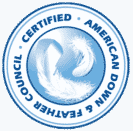Save Money While Sleeping: Down Comforters Help Lower Energy Costs
Ten tips for buying and caring for a down comforter
NEW YORK, NY – Down and feather bedding is not only comfortable, it can save money and resources. The current emphasis on reducing costs and being environmentally responsible make sustainable, recyclable down bedding the economical, eco-conscious way to stay warm. Save money and resources. The U.S. Department of Energy recommends lowering thermostats by 10˚-15˚ for eight hours a day in order to save 10% on your heating bill. That is a 1% savings for each degree, which really adds up during the cold winter months. Because of its natural insulating properties, down makes it easy to lower the thermostat and remain comfortable in bed. Down insulates by trapping warm air and wicking away moisture making it a breathable and light way to keep warm. Ounce for ounce, down is the best insulator on earth. Down is 100 percent natural, as well as completely renewable and biodegradable, unlike synthetic bedding fills, which are usually petroleum based. Ten quick tips for buying and caring for a down comforter:
- The best comforter stitching allows the down to remain fluffy while minimizing shifting and bunching. Baffle (three dimensional boxes) and sewn-through constructions are the best options.
- Look for comforters with shells made of 100 percent cotton and at least a 230 thread count, this will maximize fluffiness and will keep the down from escaping the comforter.
- Oversized comforters tend to drape better and accommodate larger mattresses.
- The term “fill power” on the label refers to the comforter’s insulating ability, the higher the fill power, the more insulating ability per ounce. Look for products with fill powers of 525 or higher.
- Place a cover over your down comforter to protect it from dust, dirt and body oils.
- Shake out comforters regularly to prevent the down from bunching up.
- Comforters can be refreshed by being aired out on a clothesline or shaken out a window.
- It is important to follow the instructions on the care label, but most comforters can be machine washed on the gentle cycle using mild non-bleach detergent. For oversized comforters, use a Laundromat with oversized washing machines.
- To dry a comforter, place it in a dryer on a low setting, toss in two or three tennis balls to break up any clumps that formed during washing. Drying times vary, but the process may take several hours. It is important that the comforter be thoroughly dried before use or storage to avoid mildew.
- Look for products that carry guarantees against defects in materials and workmanship. The best products have the longest warranties, making them the best value.
Reading the product label.
Federal and state regulations specify how down and feather products may be labeled. To be certain that their comforters are accurately labeled, consumers should look for the ADFC’s Seal of Approval on the packaging. The presence of the Seal of Approval on a product’s package indicates that the manufacturer participates in the ADFC’s Labeling Compliance Program and is committed to truth-in-labeling. For additional information on down and feather bedding visit the ADFC Website at www.downandfeather.org.
About ADFC
The American Down and Feather Council, a section of the Home Fashion Products Association, is a voluntary association of manufacturers of natural-fill bedding products, as well as dealers, buyers, sellers and processors of feathers and down for use in home fashion products. The goal of the ADFC is to further the common interests of the down and feather products industry, and to maintain and improve product quality. The objective of the ADFC Labeling Compliance Program is to ensure all natural-fill bedding products sold in the U.S. are labeled correctly and that the quality of the products meets or exceeds the claims made on the label or packaging.

